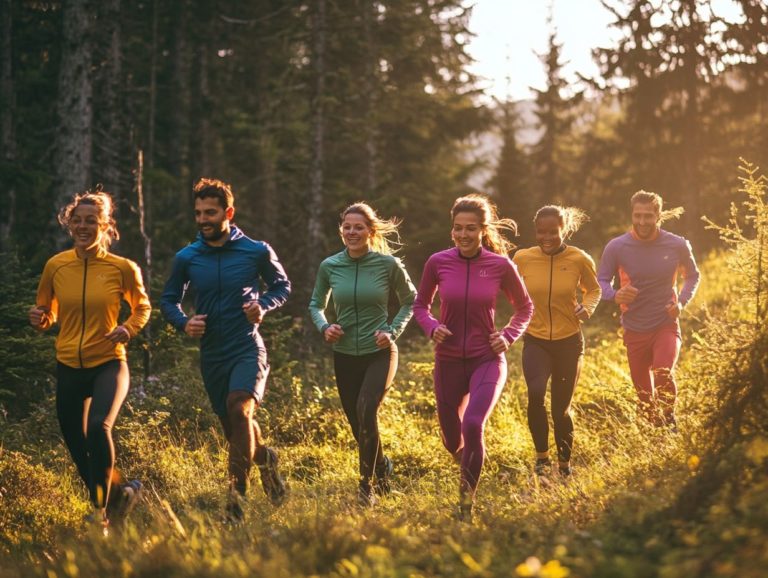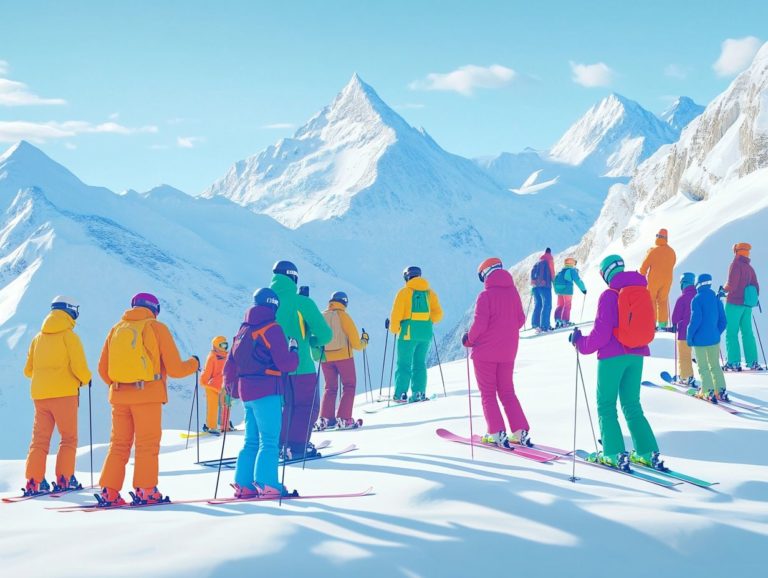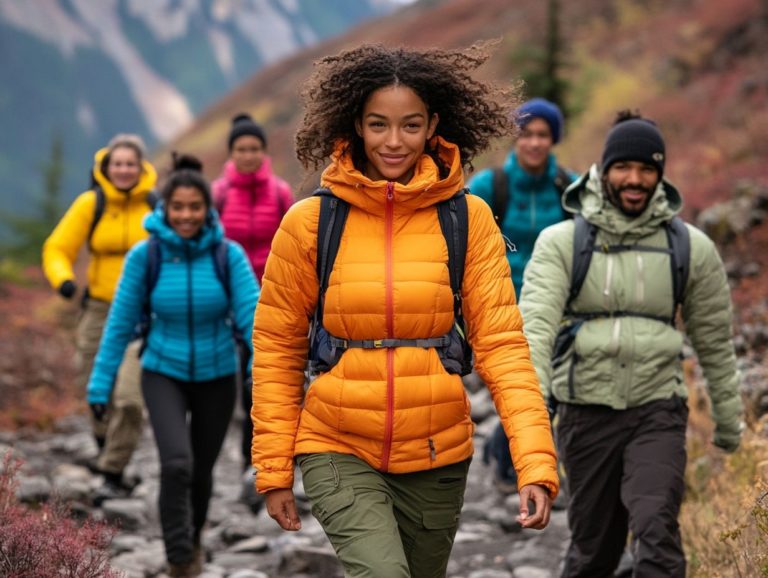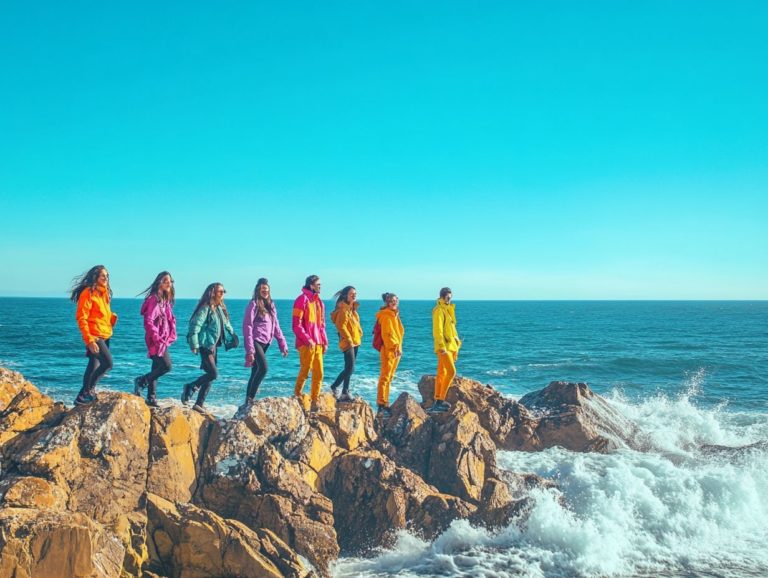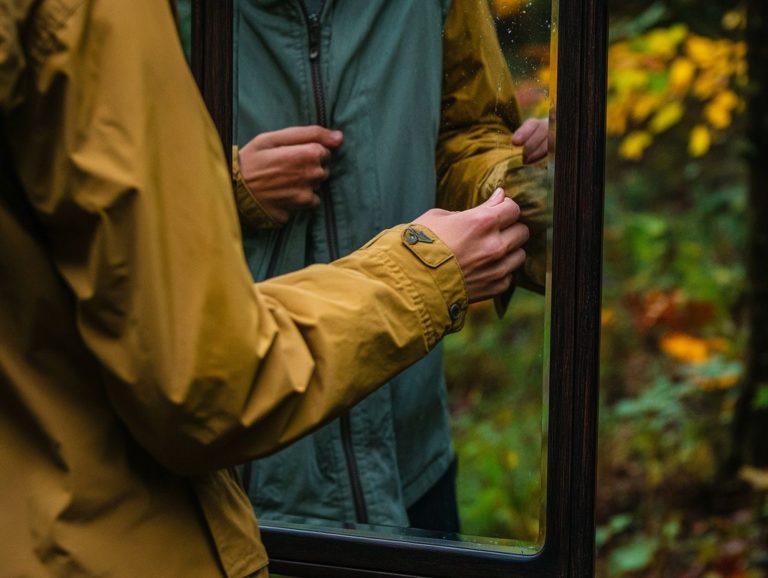The Best Outdoor Clothing for Snowshoeing
When it comes to snowshoeing, having the right gear can significantly enhance your comfort and overall enjoyment.
Choosing the right clothing from waterproof jackets to insulated pants is essential for staying warm and dry in challenging winter conditions. Let s dive into what you need to know about the best outdoor clothing for snowshoeing, covering key apparel, essential accessories, and crucial tips on layering and material selection.
Prepare to tackle the snow with confidence and style!
Contents
- Key Takeaways:
- 1. Waterproof and Breathable Jacket
- 2. Insulated Pants or Bibs
- 3. Warm Base Layers
- 4. Wool Socks
- 5. Waterproof and Insulated Boots
- 6. Gaiters
- 7. Warm Hat and Gloves
- 8. Sunglasses or Goggles
- 9. Snowshoes
- 10. Trekking Poles
- 11. Backpack
- 12. Hand and Foot Warmers
- 13. Emergency Kit
- 14. Whistle
- 15. Navigation Tools
- What to Consider When Choosing Outdoor Clothing for Snowshoeing?
- Frequently Asked Questions
Key Takeaways:
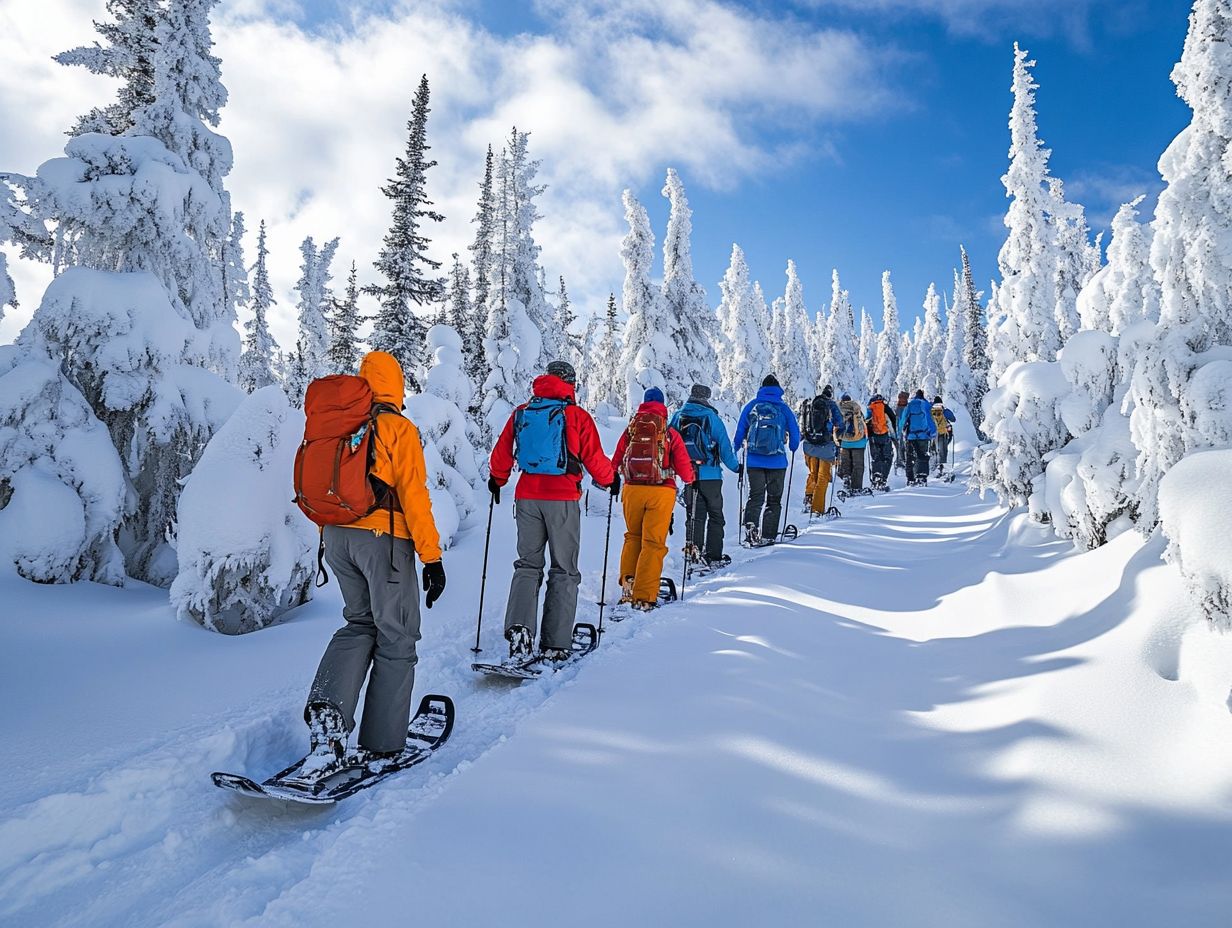
- Invest in a waterproof and breathable jacket for snowshoeing to stay dry and comfortable in wet and snowy conditions.
- Choose insulated pants or bibs to keep your lower body warm while snowshoeing.
- Layer up with warm base layers, wool socks, and insulated boots to stay warm and dry during your snowshoeing adventures.
1. Waterproof and Breathable Jacket
A waterproof and breathable jacket is crucial for winter hiking, especially in unpredictable regions like Vancouver, BC.
This jacket features materials like Gore-Tex that block moisture while letting sweat escape. Pay close attention to breathability ratings; they indicate how well the jacket can handle activity without turning into a sauna.
The right insulation whether down or synthetic fibers offers warmth without unnecessary bulk. When layering with this jacket, opt for moisture-wicking base layers and a warm mid-layer.
This combination creates a comprehensive winter ensemble that expertly manages both heat and moisture. So, whether you re navigating snow-blanketed paths or tackling icy trails, you can trust that you’ll remain comfortable and protected throughout your adventure.
2. Insulated Pants or Bibs
Insulated pants or bibs are essential for keeping you warm and comfortable during winter hiking adventures, especially when you re snowshoeing or traversing chilly trails in places like Vancouver, BC.
When deciding between insulated pants and bibs, it often comes down to your personal preferences regarding warmth and mobility. Insulated pants generally allow for greater freedom of movement, making them a go-to choice for those who value agility on uneven terrain.
Bibs offer extra coverage and warmth, particularly in the lower back area, thanks to their higher cut. Both options can feature advanced insulation materials like down or synthetic fills, each with its own advantages.
For instance, down typically provides an impressive warmth-to-weight ratio, while synthetic options excel in retaining warmth even when wet. Choose waterproof and breathable fabrics to manage moisture effectively, ensuring you stay dry and comfortable throughout your journey.
Renowned brands like MEC offer a variety of products specifically designed for winter activities, so you can remain cozy without compromising on mobility.
3. Warm Base Layers
Warm base layers are essential to crafting a successful winter hiking outfit, providing the insulation and moisture-wicking properties that ensure your comfort in cold, wet conditions.
They act as your first line of defense against the elements, efficiently drawing moisture away from your skin and helping your body maintain a stable temperature.
Materials like merino wool and polyester each have their advantages. Merino wool is known for its natural temperature regulation and odor-resistant qualities, making it a top choice for those who prioritize comfort on long treks.
Conversely, polyester excels in durability and quick-drying capabilities, invaluable when navigating unpredictable weather. The right choice not only enhances your performance but also integrates seamlessly into your overall layering system, allowing you to fully immerse yourself in your outdoor adventure without the nagging distraction of discomfort.
4. Wool Socks
Investing in high-quality wool socks, especially those crafted from merino wool, is vital for maintaining warmth and comfort during winter hiking adventures.
This remarkable fiber boasts exceptional thermal properties, which means it helps to regulate your body temperature. This ensures you remain cozy without overheating. Merino wool also excels in moisture-wicking (drawing sweat away from your skin), keeping your feet dry and minimizing the risk of blisters. The combination of these attributes makes it an outstanding choice for anyone venturing into cold climates.
Popular brands like Smartwool, Darn Tough, and Icebreaker offer durable and comfortable socks for outdoor enthusiasts. When selecting your wool socks, consider factors such as thickness, fit, and cushioning to ensure optimal performance on the trails.
5. Waterproof and Insulated Boots
Choosing the right waterproof and insulated boots is crucial for your winter hiking endeavors, particularly in snowy regions where traction and warmth are essential for safety and comfort.
When selecting your winter boots, pay attention to several key features:
- Insulation type: The insulation type is vital for keeping your feet warm. Materials like Thinsulate or down are excellent choices, offering impressive heat retention without adding unnecessary bulk.
- Waterproof materials: Opt for waterproof materials such as Gore-Tex to ensure moisture doesn’t intrude, allowing you to enjoy a dry and pleasant trek.
- Traction: Don’t underestimate the importance of traction; look for boots with rugged outsoles specifically designed to grip slippery surfaces effectively.
- Brands: Renowned brands like Salomon and Helly Hansen offer high-quality designs that blend functionality and style.
- Fit and comfort: Never overlook fit and comfort. Properly fitting boots are essential for preventing blisters and enhancing mobility during your outdoor adventures.
6. Gaiters
Gaiters provide an extra layer of protection against snow, moisture, and debris while you’re out snowshoeing.
These versatile pieces of gear come in a variety of styles, including low-cut, mid-height, and full-length options, tailored for different activities and conditions. Low-cut gaiters work well for light snow, offering breathability while keeping you comfortable. Mid-height gaiters are perfect for deeper snow, providing added warmth. For maximum protection, full-length gaiters wrap snugly around your boots, ensuring not a flake of snow sneaks in.
By incorporating gaiters into your winter ensemble, you can significantly enhance your comfort, keeping you dry and well-insulated throughout your adventures. When paired with other layers, gaiters not only complete your winter look but also act as a vital barrier against cold air and moisture, paving the way for a more enjoyable hiking experience.
7. Warm Hat and Gloves
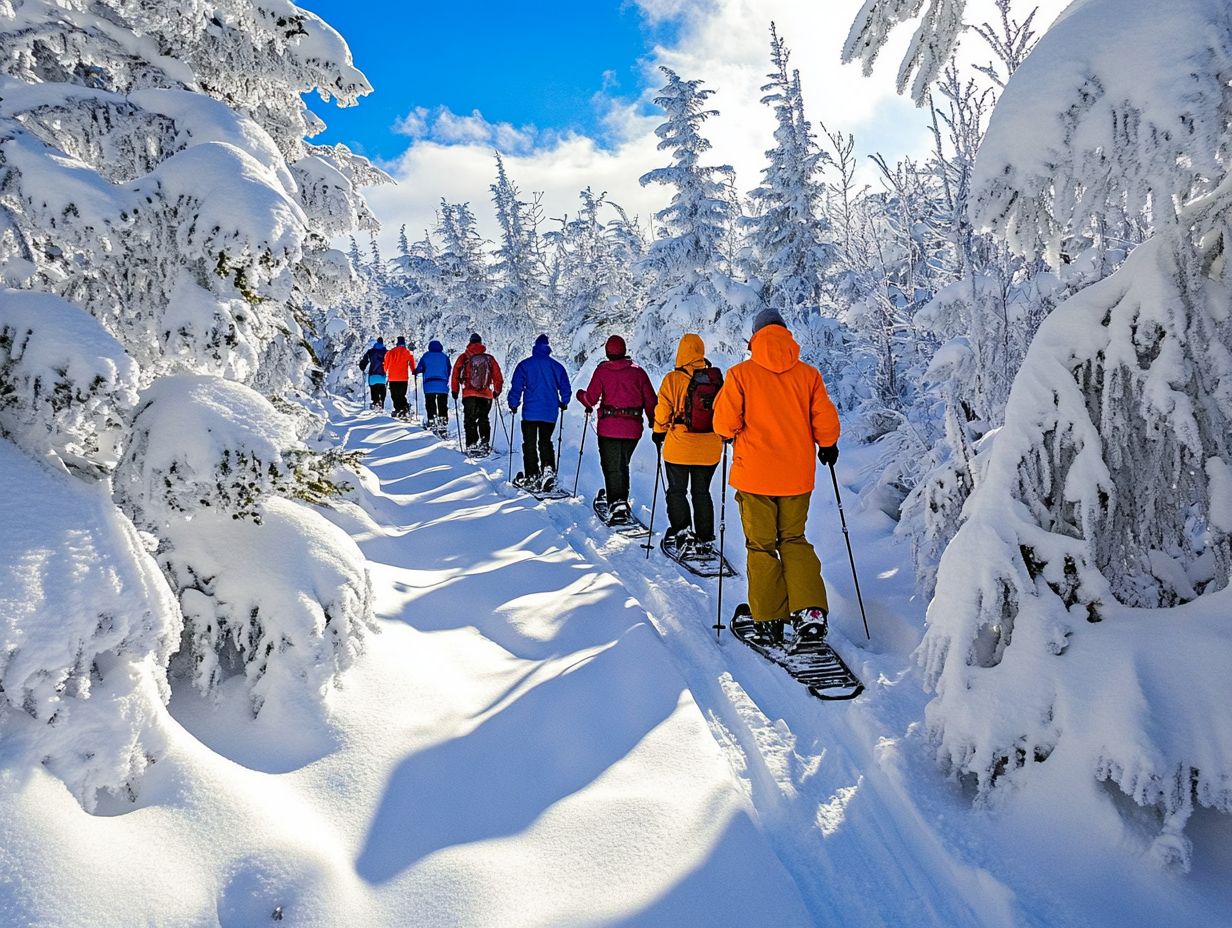
A warm hat and gloves are essential accessories for your winter hiking adventures, ensuring your extremities remain cozy and functional in harsh conditions.
When choosing the best options for these crucial items, seek materials like fleece or other insulated fabrics that deliver both warmth and breathability. Hats that fit snugly under a helmet or stylish beanie-style options provide extra protection against the biting wind.
Gloves crafted from waterproof and insulated materials will keep your hands dry and warm, even during prolonged exposure to the cold.
Brands like Outdoor Research present versatile choices that blend functionality with comfort, making them perfect for layering. Opting for gloves with removable liners adds flexibility, allowing you to adapt to shifting conditions effortlessly.
8. Sunglasses or Goggles
Wearing sunglasses or goggles is essential during your winter hiking and snowshoeing adventures. They shield your eyes from UV rays and the glare bouncing off the snow. This crucial eyewear enhances visibility and protects your eyes from harmful ultraviolet radiation, which can be especially intense in snowy conditions due to reflection.
By opting for sunglasses or goggles with polarized lenses, you can significantly reduce glare. This allows for clearer vision and less eye strain. Look for features like anti-fog coatings, which are invaluable during physical activities in cold environments where fogging can easily obstruct your view.
If you’re seeking versatility, stylish sunglasses designed for winter conditions might catch your eye. You might prefer the full coverage and added protection that goggles provide, ensuring each of your adventures remains both enjoyable and safe.
9. Snowshoes
Investing in high-quality snowshoes, such as the MSR Lightning Ascent, can truly elevate your winter hiking adventures. They enable you to navigate snowy terrains with remarkable ease.
Various types of snowshoes cater to different activities and environments, ranging from light recreational models to those crafted for deep backcountry exploration. Most feature a robust aluminum frame and durable materials, ensuring stability and traction on both packed and powdery snow.
Some designs focus on being lightweight for speed, while others provide excellent flotation in soft conditions. When selecting the perfect pair, consider the terrain you’ll be tackling, your body weight, and any specific features you desire, such as bindings and grip types.
In places like Vancouver, BC, with its stunning landscapes, snowshoeing offers a fantastic workout and presents an opportunity to explore serene, snow-covered forests and breathtaking mountain vistas.
10. Trekking Poles
Trekking poles are invaluable allies for your winter hiking excursions. They enhance your stability and balance as you navigate snow-covered trails and rugged terrain.
These versatile tools provide support and significantly reduce the impact on your joints. They offer crucial injury prevention and help you maintain a steady rhythm during those long treks. If you re venturing into icy landscapes, choose poles with carbide tips to enhance your grip and control on slippery surfaces.
Don t overlook the importance of a comfortable, ergonomic grip it s key to reducing fatigue during extended use. Regular maintenance, like checking for any bent sections or ensuring the locking mechanisms are in top shape, will extend the life of these essential hiking companions.
This makes certain that every winter adventure you embark on is both safe and enjoyable.
11. Backpack
A reliable backpack is essential for winter hiking, acting as your trusted companion for carrying crucial gear and granting you swift access to your winter hiking checklist.
When choosing your perfect pack, size plays a vital role. A well-fitting backpack ensures comfort on those long treks. Seek out multiple compartments to keep your gear organized. This feature is invaluable when you need to snag snacks or extra layers without fumbling around.
Consider hydration compatibility as well. A reservoir sleeve can provide quick sips while you re on the move, which is particularly important in colder climates. Quick-access pockets for essentials like maps and snacks enhance your efficiency on the trail, allowing you to soak in the breathtaking scenery rather than rummaging through your pack.
12. Hand and Foot Warmers
Hand and foot warmers are must-have items for your winter hiking adventures. They provide crucial warmth to keep you comfortable, even in the most frigid conditions.
These warmers come in a delightful range of options. You can choose from disposable packs that deliver instant heat or rechargeable varieties that you can reuse all season long. Disposable warmers are wonderfully compact, easily slipping into your gloves or boots, making them perfect for quick outings. Rechargeable warmers are great for longer trips, allowing you to power them up effortlessly between uses.
It’s easy to add warmers to your gear. Just stash a selection in your backpack, and you ll be ready to tackle icy temperatures, whether you re conquering a snowy trail or enjoying a day on the slopes.
13. Emergency Kit
An emergency kit is a crucial part of your winter hiking checklist. It ensures you’re ready for the unexpected while snowshoeing.
Equipping yourself with the right supplies can truly make a difference when confronted with harsh winter conditions. Essential items include a first-aid kit complete with bandages and antiseptic wipes to address minor injuries. Fire starters, whether waterproof matches or reliable lighters, are vital for warmth and signaling for help in emergencies.
Navigation tools, like a map and compass or a GPS device, are your lifeline if you find yourself disoriented. Being prepared is a responsibility that can protect lives and enhance your outdoor experience, making it both safer and more enjoyable.
14. Whistle
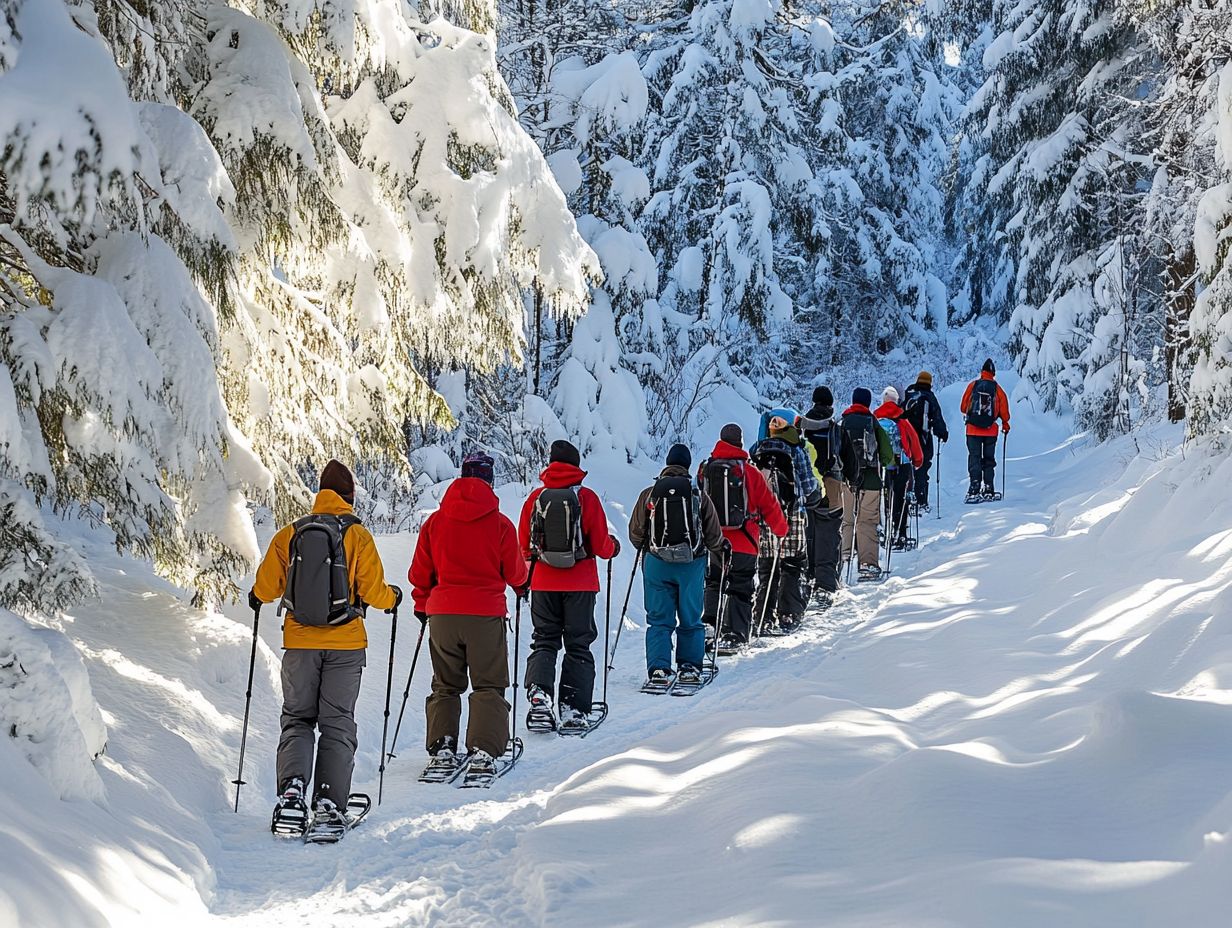
A whistle is a small yet essential tool in your winter hiking emergency kit. It enables you to signal for help if you find yourself lost or in an emergency situation.
Unlike shouting, which can sap your energy and may go unheard in windy conditions, a whistle carries sound much farther with minimal effort. Its distinct tone is more likely to penetrate nature’s cacophony and attract the attention of rescuers.
To maximize its effectiveness, attach the whistle to your gear in an easily accessible spot, such as the shoulder strap of your backpack or a lanyard around your neck. This strategic placement ensures you can grab it swiftly without fumbling, making it an essential addition to your safety arsenal while you enjoy the beauty of the great outdoors.
Proper navigation tools are essential for winter hiking. They enable you to stay oriented and safe as you traverse snowy terrains while steering clear of potential hazards.
These tools range from traditional methods like maps and compasses to cutting-edge technologies such as GPS devices, which provide precise locations in an instant. While maps offer a broader perspective of the landscape, compasses serve as reliable guides through unfamiliar areas, ensuring you maintain your sense of direction.
Incorporating weather apps into your planning is crucial. These applications deliver real-time updates on conditions, significantly enhancing your safety and preparedness. They allow you to anticipate weather changes and sidestep treacherous situations.
What to Consider When Choosing Outdoor Clothing for Snowshoeing?
When selecting outdoor clothing for snowshoeing, consider factors like the layering system, the weather forecast, and the specific terrain conditions you ll navigate, especially in areas like Vancouver, BC.
By emphasizing layering, you can effortlessly adjust your clothing to maintain optimal comfort, no matter how temperatures fluctuate during your adventure. A moisture-wicking base layer helps keep sweat away from your skin, while an insulating mid-layer provides essential warmth for colder climates. For your outer garments, windproof and waterproof shells protect against the elements.
Don t overlook key items from your winter hiking checklist, such as:
- Thermal gloves
- A warm beanie
- Insulated, waterproof boots
With these must-have items, you ll be ready for an exhilarating and safe snowshoeing adventure!
How to Dress in Layers for Snowshoeing?
Dressing in layers is your go-to strategy for winter hiking and snowshoeing. This approach gives you the flexibility to adapt to changing temperatures and activity levels throughout your adventure.
This multi-layered method consists of a base layer, mid layer, and outer layer, each serving a distinct purpose. The base layer, typically made from moisture-wicking materials, pulls sweat away from your skin essential during those vigorous moments.
The mid layer provides insulation, helping you retain body heat while still allowing for breathability. The outer layer is your protective barrier against wind, snow, and rain.
Adjust your layers promptly to stay comfortable and enjoy every moment remove a mid layer if you start feeling too warm or add an outer shell if the wind picks up. By staying in tune with your body and the weather, you’ll ensure a comfortable adventure.
What Materials Are Best for Snowshoeing Clothing?
Choosing the right materials for your snowshoeing clothing is essential for comfort and protection against the elements. Options like merino wool and synthetic insulation are top contenders.
Merino wool is a standout choice, known for its excellent moisture management properties. It efficiently pulls sweat away from your body while retaining warmth, even in damp conditions. This natural fiber also provides remarkable odor resistance, helping you stay fresh during extended outdoor adventures.
Synthetic insulation shines with its ability to provide significant warmth, even when wet. This makes it ideal for unpredictable winter days when the weather can t seem to make up its mind.
By understanding the benefits of these materials, you can make informed choices about your footwear and clothing, enhancing your overall snowshoeing experience.
How to Stay Warm and Dry in Cold and Wet Conditions?
Staying warm and dry in cold and wet conditions is essential for a safe winter hiking experience. It requires a thoughtful selection of clothing and accessories tailored to tackle these challenges.
Master the art of layering—an approach that retains heat while managing moisture effectively. Begin with a moisture-wicking base layer, add insulating layers, and finish with a waterproof, breathable outer shell. For those venturing into cold climates, it’s crucial to equip yourself with the best survival gear for cold weather. High-quality materials like Gore-Tex ensure that while water is kept at bay, breathability is preserved to prevent overheating.
Well-fitted accessories like thermal gloves, beanies, and neck gaiters significantly boost warmth, ensuring that no extremities fall prey to the relentless winter elements.
What Are the Essential Features to Look for in Snowshoeing Clothing?
When choosing your snowshoeing clothing, prioritize essential features like insulation, waterproofing, and breathability to ensure your comfort during winter hiking adventures.
These factors are crucial for maintaining your optimal body temperature and preventing uncomfortable moisture buildup. Different insulation types, such as synthetic or down, provide varying levels of warmth without weighing you down, allowing for free movement.
A high waterproof rating is essential for keeping snow and slush at bay, ensuring you stay dry and warm all day long. Breathability is key for letting perspiration escape efficiently, preventing the dampness that can lead to chills. Together, these features create a harmonious environment that enhances both your safety and enjoyment during outdoor winter activities. For those venturing into the city, consider checking out the best outdoor clothing for urban exploration.
Frequently Asked Questions
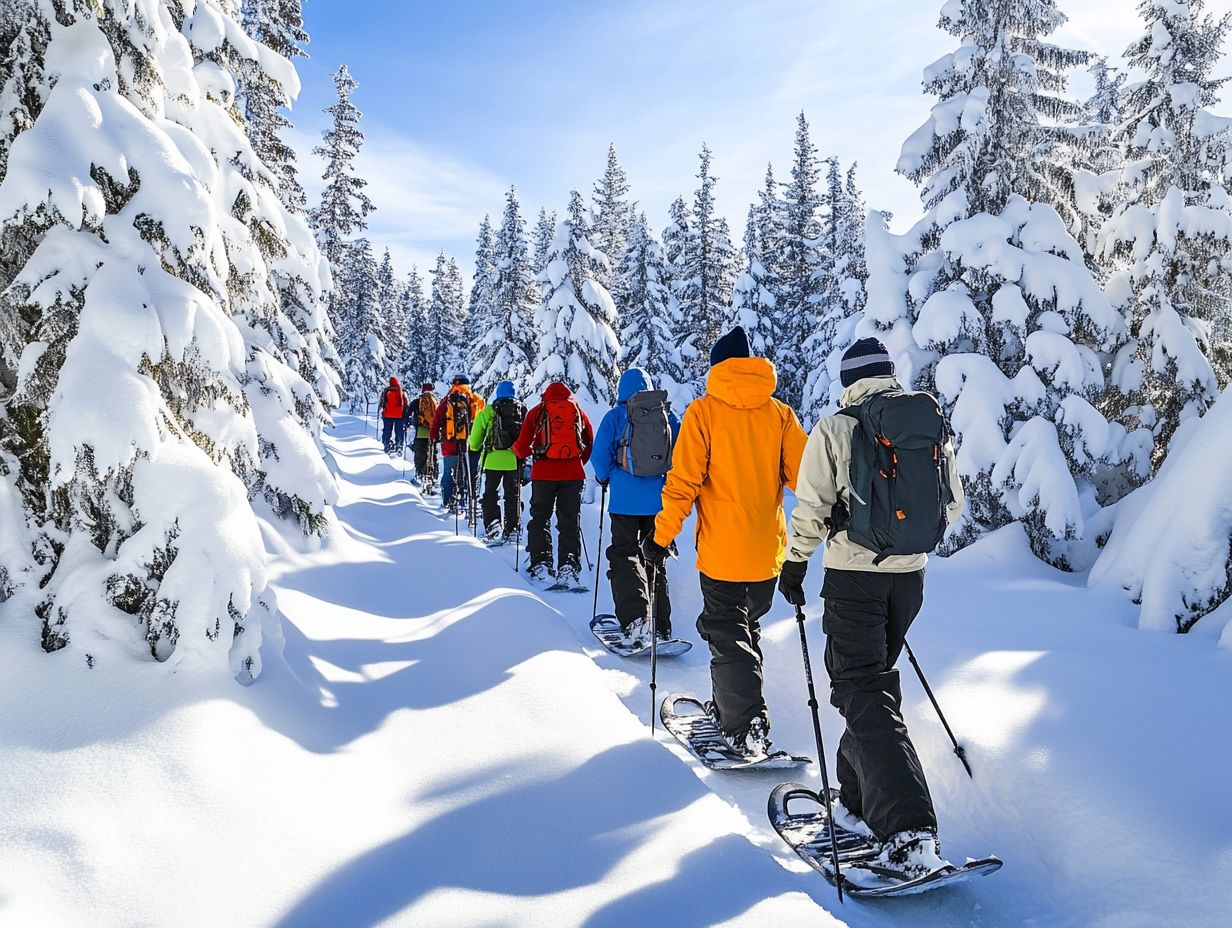
What should I wear for snowshoeing?
For snowshoeing, wear clothing that balances warmth, waterproofing, and breathability. Layering is key: start with a moisture-wicking base layer, followed by an insulating mid layer, and topped with a waterproof outer layer. Don’t forget warm socks, gloves, and a hat to protect your extremities.
What type of jacket is best for snowshoeing?
A waterproof and breathable jacket is essential for snowshoeing. Choose jackets made for winter sports. Features like a hood, adjustable cuffs, and a powder skirt will keep the snow at bay.
Are snow pants necessary for snowshoeing?
Snow pants can really boost your comfort while snowshoeing! They provide extra warmth and protection from the elements. If you opt out of snow pants, ensure your base and mid layers are warm enough for the conditions.
What kind of footwear should I wear for snowshoeing?
Wear sturdy, waterproof boots with your snowshoes. Look for boots with good traction and ankle support. Alternatively, waterproof hiking boots with gaiters can keep the snow out.
How should I layer for snowshoeing in varying temperatures?
Master your layering game for an unforgettable snowshoeing adventure! In colder temperatures, add an insulating layer and make sure your outer layer is fully waterproof. As temperatures rise, remove layers to avoid overheating. Always carry extra layers in your backpack just in case.
What type of gloves are best for snowshoeing?
Waterproof and insulated gloves are best for snowshoeing. Look for gloves designed for winter sports, featuring adjustable cuffs and touchscreen compatibility. Bring a pair of glove liners for extra warmth if needed.

